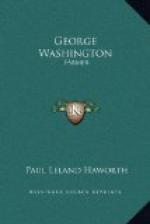In this same year, 1760, we find him sowing clover, rye, grass, hope, trefoil, timothy, spelt, which was a species of wheat, and various other grasses and vegetables, most of them to all intents and purposes unknown to the Virginia agriculture of that day.
He also recorded an interesting experiment with fertilizer. April 14, 1760, he writes in his diary:
“Mixed my composts in a box with the apartments in the following manner, viz. No. 1 is three pecks of earth brought from below the hill out of the 46 acre field without any mixture. In No. 2 is two pecks of sand earth and one of marle taken out of the said field, which marle seemed a little inclined to sand. 3 has 2 pecks of sd. earth and 1 of river sand.
“4 has a peck of Horse Dung
“5 has mud taken out of the creek
“6 has cow dung
“7 has marle from the Gulleys on the hillside, wch. seem’d to be purer than the other
“8 sheep dung
“9 Black mould from the Gulleys on the hill side, wch. seem’d to be purer than the other
“10 Clay got just below the garden
“All mixed with the same quantity and sort of earth in the most effective manner by reducing the whole to a tolerable degree of fineness and rubbing them well together on a cloth. In each of these divisions were planted three grains of wheat, 3 of oats, and as many of barley, all of equal distances in Rows and of equal depth done by a machine made for the purpose. The wheat rows are next the numbered side, the oats in the middle, and the barley on the side next the upper part of the Garden. Two or three hours after sowing in this manner, and about an hour before sunset I watered them all equally alike with water that had been standing in a tub abt two hours exposed to the sun.”
Three weeks later he inspected the boxes and concluded that Nos. 8 and 9 gave the best results.
The plows of the period were cumbersome and did their work poorly. Consequently in March, 1760, Washington “Fitted a two Eyed Plow instead of a Duck Bill Plow”, and tried it out, using his carriage horses in the work. But this new model proved upon the whole a failure and a little later he “Spent the greater part of the day in making a new plow of my own Invention.” Next day he set the new plow to work “and found She answerd very well.”
A little later he “got a new harrow made of smaller and closer teethings for harrowing in grain—the other being more proper for preparing the ground for sowing.”
Much of his attention in the next few years was devoted to wheat growing, for, as already related, he soon decided gradually to discontinue tobacco and it was imperative for him to discover some other money crop to take its place. We find him steeping his seed wheat in brine and alum to prevent smut and he also tried other experiments to protect his grain from the Hessian fly and rust. Noticing how the freezing and thawing of the ground in spring often injured the wheat by lifting it out of the ground, he adopted the practice of running a heavy roller over the wheat in order to get the roots back into the ground and he was confident that when the operation was performed at the proper time, that is when the ground was soft and the roots were still alive, it was productive of good results.




